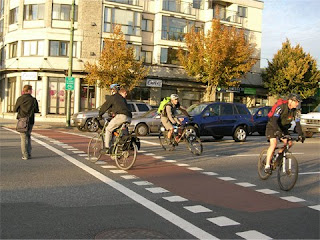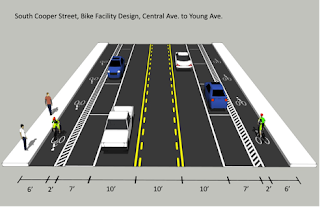Meanwhile, here in Memphis it’s hot as Hades. The ambiance is thick--day after day—and only rarely in the last two months have we seen a break in the daytime heat. And by break I mean a drop from triple digits to lower nineties.
It’s amazing how unrelenting difficulty can enhance one’s appreciation for brief moments of ease.
It’s also an exciting time here in Memphis. This city appears to be on the verge of making sustainable infrastructure development a priority, and NGOS, non-profits, and the municipalities all appear to be falling in line—offering their political support and often financial support for the creation of bike facilities, sidewalks, and greenlines.
The City of Memphis will announce it’s new bike and pedestrian coordinator in the coming week; The Shelby Farms Greenline will open in October; Memphis Mayor A.C. Wharton has committed to creating 60 miles of bike facilities within the next 18-24 months, and Walk Bike Memphis is working to fund bike paths through Overton Park, along Broad St., and on into the Shelby Farms Park Greenline.
The Greater Memphis Greenline will begin work on acquiring and developing three new greenlines while maintaining a long-term focus on the acquisition of right of way for more than 400 miles of MLGW utility easements. And The Wolf River Greenline is progressively heading west: the connector from Shady Grove to Walnut Grove is currently under construction.
A new bicycle shop, Victory Bicycle Studio, is set to open on Young Avenue September 1st. The Peddler Bicycle Shop has become an exclusively Trek store while Outdoors Inc. and Midtown Bicycle Company continue to serve bicyclists between Highland and the River. Revolutions Community Bicycle Shop is continually growing in it’s ability to work with community partners: its latest project—in addition to its ongoing effort to help Memphians construct their own affordable bicycles—is a partnership with Leadership Memphis that will afford students in the leadership class the chance to work with youth to build a bike. Revolutions continues to inspire with its ability to build bicycles while building community.
It’s an exciting time to be a Memphian. And, considering the last 10 years spent working on these issues, it’s thrilling to see a very different city being built before our eyes. Southern Avenue has become my own personal symbol for this progress: I spent hundreds of hours speeding up and down Southern Ave. on my bicycle, navigating the narrow stretches of roadway with experience and caution.
But within the month Southern will have bicycle lanes.
It’s unclear just how much of the street will have bike lanes—we’re hoping the entire stretch from Cooper to Goodlett will receive lanes this month—but to have a dedicated bicycle facility on this critical corridor of connectivity between Midtown and the University lifts my heart.
Memphis is on the Move. And it reminds me of a speech the Rev. Dr. Martin Luther King Jr. delivered on the steps of the Alabama capital in 1965. Marchers had just trod from Selma to Montgomery to demonstrate support for the federal Voting Rights Bill that would be passed in August of that year. King could clearly see a break in the heat—it was that ebb of days in the low 90s amidst the sweltering oppression of ongoing racial injustice. And King knew that the freedom struggle was at its height; most importantly, he knew no-one could turn the movement around. He said:
We’ve come a long way since that travesty of justice was perpetrated upon the American mind. James Weldon Johnson put it eloquently. He said:
We have come over a way
That with tears hath been watered.
We have come treading our paths
Through the blood of the slaughtered.
Out of the gloomy past,
Till now we stand at last
Where the white gleam
Of our bright star is cast.
We have come treading our paths
Through the blood of the slaughtered.
Out of the gloomy past,
Till now we stand at last
Where the white gleam
Of our bright star is cast.
Today I want to tell the city of Selma, today I want to say to the state of Alabama, today I want to say to the people of America and the nations of the world, that we are not about to turn around. We are on the move now.
Yes, we are on the move...Like an idea whose time has come, not even the marching of mighty armies can halt us. We are moving to the land of freedom.
The stakes were higher in the Civil Rights movement than they are in the movement to make our streets safe for bicycles and pedestrians.
But the stakes are equally as high for Memphis generally.
And maybe, even when seen in this broad way, our city is indeed on the move.
But questions persist: will we stave off poverty for a third of our population, end the brain drain, improve education, work with our homeless brothers and sisters, end the bloodshed in the streets, and build a sustainable city—a city that has a sense of destination in 10 years, a city that enjoys a reputation for being a forward thinking place that learns from the past and forges a bright future?
I think so. But, as with King, I’m a “prisoner of hope,” one bound to a commitment for a city that succeeds. So maybe I’m not the best judge.
An editorial in the Memphis Commercial Appeal last month boasted Memphis’ ability to effectively strive towards positive development, noting the inherent good resulting from this striving. King may have agreed. He claimed “unearned suffering is redemptive,” assuring freedom fighters enduring physical and emotional beatings that none of their efforts were in vain.
But Memphis ought to move from a city that strives to a city that achieves. It’s my contention that we’ll know we’re on our way—not just on the move, but on our way—when Memphis becomes a city of achievement.
As it is, I think I’m due to call my friend in New York. We need to catch up about our lives, sure. But as I seek to find my place in this forward movement for a city that still struggles to offer opportunities, I’m interested in what it’s like to work at the Steak and Shake.




